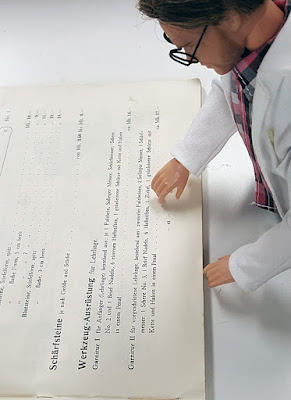Needed a little help, alright a lot of help, in the studio, something that was very evident during
Bookbinder Barbie's visit. We had fun, worked well together, and I was able to teach her about some of my favorite weird bookbinding proclivities like
making parchment from fish skin. Most of what I learned from that experience was that working alone can be hard for any number of reasons.
That got me talking to some old connections in Germany, and through them learned about a very motivated and well-versed binder, Fritz Otto Buchbinder, who was looking for some new experiences. He's a Journeyman (Geselle) working towards his Meister, learned from some very good (and not so good) binders in the trade, and spent time at one of the few remaining
art academies teaching binding. There are also a lot of under- and unemployed bookbinders around...
He arrived recently on the friendly skies of Lusthansa. They even managed to lose all his tools, save one. Ouch! To the rescue.
the New World's best tool maker, Jeff Peachey who was able to outfit him with some of his finest tools. I was able to scare up some bone folders and
Berlin-style brushes with the metal handle that he likes so much. The one tool he managed to save was the bone folder his Meister gave him as an apprentice. This Meister had gotten from the Meister of his Meisterin.
Apparently it had guided a certain Franz through his career as a binder. There it is grinning from the pocket of his lab coat.
 |
| Fritz Otto Buchbinder with his Peachey Swiss paring knife. |
 |
| The tool starter set, more will appear as they are needed and made. |
 |
Looking at paring knifes in the 1928 Braunwarth & Lüthke catalog.
Fritz prefers the Swiss and French styles of knives to the traditional German kind.
This is the result of bad experiences he had with the knife his Meister gave him –
Said it was a stumpfe Gurke... (dull cucumber). |
 |
Fritz is already getting lost in the Fachbibliothek. He's glad to find his familiar
German manuals, but is also very interested in what he can learn from the
English (and other) ones. I'm sure his English will improve quickly. |
 |
Fritz was blown away to see this binding from the "golden age" of German binding,
the period between the World Wars. |
I look forward to having Fritz Otto in the studio with me, teaching him things as well as learning from him. He's curious, loves exploring the old binding manuals and trade publications. Mostly, I'm sure he'll get me binding more. I'll also be glad for his help working on the layout and running the trains.













